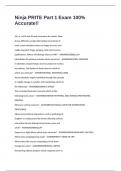Ninja PRITE Part 1 Exam 100%
Accurate!!
26 y.o. w/HA and R-hand clumsiness for weeks. Exam
shows difficulty w/rapid alternating movements of
hand, overt intention tremor on finger-to-nose, and
mildly dysmetric finger tamping. CNS intact and no
papilledema. Where will damage show on MRI? - ANSWERCEREBELLUM
Mesolimbic DA pathway includes which structure? - ANSWERVENTRAL STRIATUM
In addiction, dopaminergic neurons project to nucleus
accumbens. Cell bodies of these neurons reside in
which area of brain? - ANSWERVENTRAL TEGMENTAL AREA
Neural plasticity largely mediated through the capacity
to rapidly change in number and morphology which fo
the following? - ANSWERDENDRITIC SPINES
The uncinated fasciculus connects which of the
following brain areas? - ANSWERANTERIOR TEMPORAL AND VENTRAL PRE-FRONTAL
REGIONS
What are cortical columns? - ANSWERFUNCTIONAL UNITS FOR INFORMATION
PROCESSING
Abnormal emotional expressions such as pathological
laughter or crying caused by lesions affecting cortical-
subcortical circuits linking frontal cortex, pons and
what? - ANSWERCEREBELLUM
Exposure to light effects which brain structure? - ANSWERSUPRACHIASMATIC NUCLEUS
When does synaptogenesis peak? - ANSWERFIRST 4 YEARS OF LIFE
Where does the neuron morphology in the brain
change the most? - ANSWERPREFRONTAL CORTEX
threatening objects produce startle response prior to
,person becoming consciously aware. Connection of
thalamus to what? - ANSWERAMYGDALA
Huntington's disease characterised by loss of neurons
producing which NT - ANSWERGABA
Adult neurogenesis in which area of the brain? - ANSWERHIPPOCAMPUS
17y/o is evaluated for binge eating associated with a
60 lb weight gain over the past four months. CT shows
a craniopharyngioma that likely disrupts what
structure? - ANSWERVENTROMEDIAL HYPOTHALAMUS
Low CSF levels of this neurotransmitter metabolites is
associated with suicidality? - ANSWER5-HYDROXYINDOLE ACETIC ACID (5-HIAA)
What is the 5HT3 receptor classification? - ANSWERLIGAND GATED
Pain by neurogenic inflammation mediated by? - ANSWERSUBSTANCE P
Decreased level of what NT is most associated with
depressed mood, poor sleep, and poor impulse
control - ANSWERSEROTONIN
Psych stress increases cortisol and prolonged cortisol is
associated with bad outcomes. Stress also affects other
hormones. Increase in which hormone is correlated
with decreased PTSD severity most likely due to
hormone's anti-glucocorticoid properties: - ANSWERDHEA
Unsteady gait, appendicular ataxia in LE only and
normal eye movement. Walks with lurching broad-
based gait. (8x) - ANSWERCEREBELLAR DEGENERATION (ALCOHOLIC)
Visual problem in pituitary tumor compressing optic
chiasm (10x) - ANSWERBITEMPORAL HEMIANOPSIA
60 y/o right-handed M, getting lost, only writes on
right half of paper. Left-sided hemi-neglect. Where is
the lesion? (8x) - ANSWERRIGHT PARIETAL LOBE
Which cancer has the highest likelihood of going to
brain? - ANSWERLUNG
,66 y/o c/o frequent falls, several-month hx of anxiety,
unwillingness to leave home. On exam, mild
impairment of vertical gaze on smooth pursuit/
saccades, mild axial rigidity & minimal rigidity of
upper extremities, along w mild slowness of
movement on finger tapping, hand opening & wrist
opposition. Posture nml. Gait tentative/awkward, but
w/o shuffling, ataxia, tremor. Pt is slow in arising from
a chair. Most likely dx: (6x) - ANSWERPROGRESSIVE SUPRANUCLEAR PALSY
65 y/o pt fell several times past 6 mos. MSE nml.
Smooth pursuit, saccadic movements impaired. Worse
w vertical gaze. Full ROM w doll head maneuver. Mild
symmetric rigidity/bradykinesia, no tremor. MRI/CSF/
What is an accurate statement about the brain's default
mode network? - ANSWERIS INVOLVED IN REPROCESSING PREVIOUSLY
EXPERIENCED STIMULI
The most likely reason that adults are superior to
adolescents in abstract thinking. The brain undergoes: - ANSWERSYNAPTIC PRUNING
Dorsal-lateral-pre-frontal cortext plays important role in
what activity? - ANSWERWORKING MEMORY
Drug abuse activates neuro circuits. Generates signals
in the ventral tegmental area and to where? - ANSWERDOPAMINE INTO THE NUCLEUS ACCUMBENS
Ninety-five percent of right-handed people develop
left hemispheric dominance for language. What
percentage of left handed people develop left
hemispheric dominance for language? - ANSWER75%
Prostaglandin D2 increases extracellular levels of... - ANSWERADENOSINE
Which is a retrograde neurotransmitter? - ANSWERENDOCANNABINOIDS
Characteristics of Ach receptors in cerebral cortex - ANSWERBOTH INHIBITORY AND EXCITATORY
Neurohormone for social bonding - ANSWEROXYTOCIN
28 y.o. hospitalized with paranoid delusions, AH, and
, agitation, tx w/Haldol 5, pt becomes rigid & mute, in
days gets choreoform mvmt, has seizures, gets resp
problems leading to ICU admit. Exam shows ovarian
mass, CSF will show antibodies to: - ANSWERNMDA RECEPTORS
Neurotransmitter from responsible for rewarding
nature of drug abuse - ANSWERDOPAMINE
Role of glycine at NMDA receptor - ANSWEROBLIGATE COAGONIST
labs unremarkable. Dx? (4x) - ANSWERPROGRESSIVE SUPRANUCLEAR PALSY
26 y/o w HA, clumsiness of right hand x weeks.
Struggles with rapid alternating movements of R
hand, overt intention tremor w finger-to-nose, mildly
dysmetric finger-tapping. CNs nml, no papilledema.
Damage to what is seen on MRI? (3x - ANSWERCEREBELLUM
9 y/o F has 3 month h/o seemingly unprovoked bouts
of laughter. Worse when not sleeping well. Pt does
not feel happy during these episodes. Started
menstruating 6 months ago, and at Tanner stage 4.
Dx? (2x) - ANSWERHYPOTHALAMIC HAMARTOMA
5 y/o with 4 month history of morning HA, vomiting,
and recent problems with gait, falls, and diplopia: (2x) - ANSWERMEDULLOBLASTOMA
70 y/o develops flaccid paralysis following severe
water intoxication. He develops dysphagia and
normal. (7x) - ANSWERPSEUDOTUMOR CEREBRI
79 y/o pt with a deteriorating mental state over a 3-
week period has an exaggerated startle response with
violent myoclonus that is elicited by turning on the
room lights, speaking loudly, or touching the pt.
Myoclonic jerks are also seen. Diagnosis: (5x) - ANSWERSPONGIFORM ENCEPHALOPATHY
Pt presents with a slowly progressive gait disorder,
followed by impairment of mental function, and




